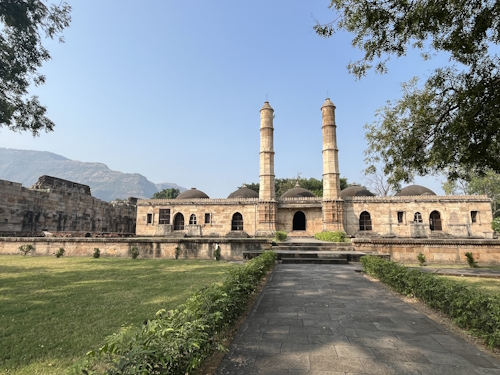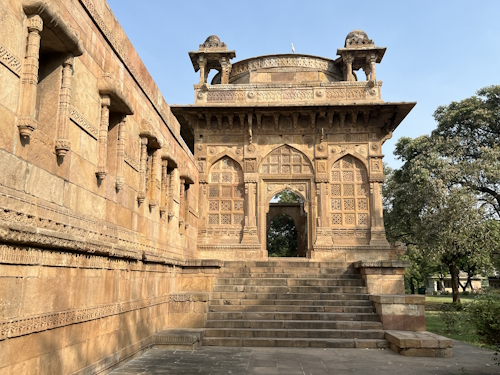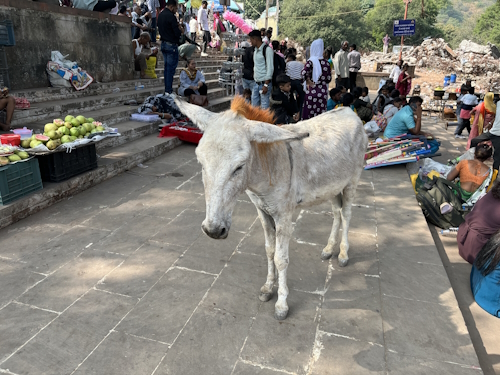Blog WHS Visits
WHS #932: Champaner-Pavagadh
Champaner-Pavagadh is one of the lesser-known Indian WHS. It is also one of the least appreciated by members of our community, although it still amounts to a decent 3 stars. The Tripadvisor reviews about this site are much more positive. One of its main issues is that it is hard to summarize what it is actually about. As the name suggests, it comprises two (contiguous) parts: Champaner (the remains of an Islamic pre-Mughal city) and Pavagadh (a hill with an important Hindu pilgrimage site). They are linked through their prime setting, the hill providing the water the city needed. As it was still relatively early in my 2024 India journey, I deep-dived into it via a day trip on public transport from Vadodara (better known locally under its old name Baroda).
The bus ride to Pavagadh takes about an hour and costs 40~60rs. Buses frequently leave from bays 15-18 at the central bus station; signage is only in Gujarati but just follow the colourful pilgrims on board. From Pavagadh bus station you have to walk about 500m to the right around the walls of the citadel, to where you can see the Jami Masjid – there used to be an entrance right across the street from the bus station (still present in Maps.me), but it is closed off nowadays and looks overgrown.
So I started my exploration with the Jami Masjid, the main mosque and the highlight of the Champaner site. I arrived at the same time as a French tour group, and there were a few local visitors as well. I was immediately taken by the very delicate stone carvings. With their geometrical motifs, they reminded me a bit of the Chaukhandi Tombs in Pakistan. The mosque is walled, with fine gateways (photo 2), and its design with two minarets against the hilly background is picture perfect. On the inside, the carvings are continued in the mihrabs and segregation walls.
For the other parts of the Primary zone of Champaner Archaeological Site, you have to enter the Citadel across the street. This is also where you encounter the infamous village; people have been living inside the walls for decades, housing is permanent and there are shops and businesses. It didn’t bother me too much actually, maybe because I saw worse last year in Pakistan (Rohtas Fort!). It is not as if they are camping on the grounds of the two precious mosques - these are well-protected and gated. Just consider it as separate locations instead of a continuous area as shown on the (very bad) official map.
At the end of the village lies the Shaher ki Masjid (photo 1). The setting with the Pavagadh Hill in the background again is very pretty and its design with multiple domes in a row is similar to what you can see in Bagerhat. In and around the village and the mosques are other points of interest, such as a water tank and a “Custom House”. The smaller Kevda Masjid and Nagina Masjid come recommended in Tripadvisor reviews as well, they can be accessed by following a small road to the right of the Custom House. There are also Jain shrines, some of which have been vandalized earlier this year, and another 11 components towards the town of Halol.
I moved on however to the Hindu pilgrimage part of this WHS: the trek to Pavagadh Hill. Over 2 million people arrive here yearly, so you don’t have to worry about finding transport or something to eat or drink. The first step involves wriggling yourself into one of the Jeeps that provide the transport from the main road (next to the bus station) to the foot of Pavagadh Hill. I think I saw at least 100 of them continuously drive the 5km up the mountain. They pack no less than 20 people in one car! A ride costs 30rs.
At the foot of the hill, the joyful pilgrimage atmosphere already is present, with a lot of people wearing orange robes or shawls. Even the donkeys, the workhorses of this mountain, wear an orange streak in their manes.
To get to the top of the hill, where the Hindu temple is, you can walk another 5km (only steps) or take the cable car (a.k.a. “ropeway”). I was already warned how long the queues could be for the cable car, but OMG: I walked and walked around the foot of the mountain to just find the start of the queue. The waiting time must surely have been 2 hours or more. I wanted to give it a go for an hour or so, to see how far I would advance – but I was “rescued” by some men ahead of me. They pointed me to Gate 3, the entrance for people who booked their cable car tickets online – no queue at all. The guard at first wouldn’t let me in (as of course I didn’t know about the booking process and there wasn’t a reliable data connection at the hill either to quickly do it), but the men argued in my favour: Foreigner! Alone! So finally the guard relented and let me in, and I was able to buy a cable car ticket (150rs) at the regular ticket office. I consider this VIP treatment as payback for the foreigner pricing practiced at all Indian WHS!
Within 15 minutes I was at the top. Here you’ll find a pond where people take ritual baths, an older temple and several shrines. To get to the Kalika Mata Temple you need to climb even more steps, but I skipped this since I had to leave my (good) shoes behind among a pile of thousands! The temple has been heavily reconstructed in 2022 anyway and construction is going on to extend the ropeway so that it arrives all the way up there.
Overall, Pavagadh Hill did feel more like a place for a family outing (I’d guess about a third of all shops along the path sell toys) than an overly religious place. Walking back down, however, I witnessed how the pious tackle this hill: by bowing down and putting a dab of red powder on the stairs at every single step they climb!
Els - 17 November 2024


